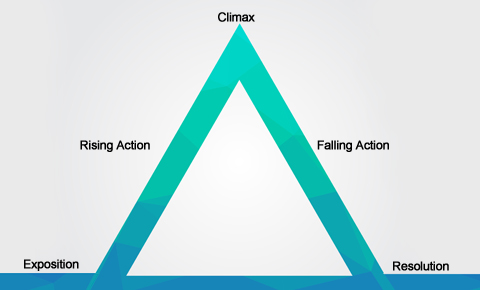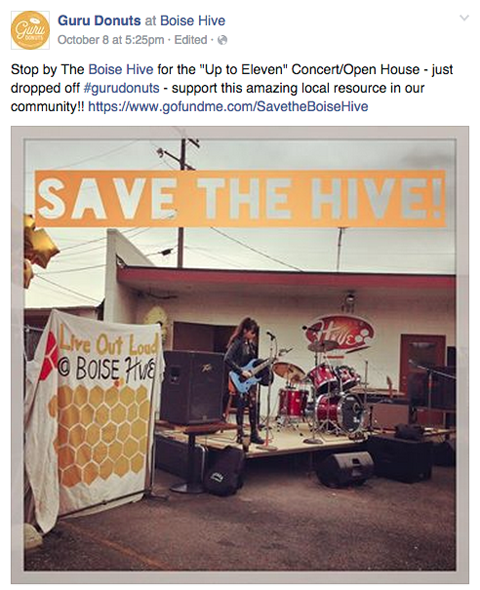 Do you want to use storytelling in your social media marketing?
Do you want to use storytelling in your social media marketing?
Are you looking for inspiration?
Building your social media campaigns around stories helps you stand out from other brands, and grab the attention of consumers.
In this article you'll discover five ways to use storytelling in your social media marketing.

Listen to this article:
Where to subscribe: Apple Podcasts | Spotify | YouTube Music | YouTube | Amazon Music | RSS
#1: Pay Attention to Story Structure
Freytag's pyramid is a powerful storytelling framework used in a variety of creative works from Aesop's Fables to Shakespeare's plays.
This structure splits the story into five narrative arcs, evoking various emotional reactions from your audience. These arcs include the inciting moment, the complication or rising action, the climax (or turning point), the reversal or falling action and the moment of release.
In your storytelling you can follow the steps in Freytag's pyramid or use them in parts, but the approach helps you make an emotional connection with your consumers.

In 2014 Jaguar launched a high-suspense campaign with David Beckham in China, targeting local social networks WeChat and Weibo. Before revealing Beckham as the brand ambassador, the campaign asked consumers to guess Mr. Jaguar's identity.
Jaguar released street interviews and videos to build suspense. They also dropped hints throughout the campaign to get consumer traction. The exercise was highly successful and drew 50,000 reposts when it started. An additional 30,000 reposts came in after David Beckham was introduced as the ambassador.
#2: Sequence Your Ads to Create Stories
According to the recently published The Power of Storytelling from Facebook IQ, online storytelling on social media can have a direct impact on in-store purchases.
As an experiment, Refinery29 tested Facebook ads that were sequenced like stories. Overall, the experiment yielded a 56% conversion lift and an 87% rise in view-throughs. Refinery29 also saw a 7% increase in in-store purchases and a 10% increase in online purchases.

Deliver sequenced Facebook ads that combine quality content with a strong call to create a social media-led storytelling campaign like this one.
#3: Align Your Story with Audience Values
A belief ecosystem allows you to move away from product-oriented branding to a more lifestyle or customer value-oriented branding. This is a natural fit for social media where businesses need to define a niche target group (the first believers), develop a brand communication strategy (giving consumers a simple and clear reason to believe) and create online and offline spaces for brand reach and to share stories.
Get World-Class Marketing Training — All Year Long!
Are you facing doubt, uncertainty, or overwhelm? The Social Media Marketing Society can help.
Each month, you’ll receive training from trusted marketing experts, covering everything from AI to organic social marketing. When you join, you’ll also get immediate access to:
- A library of 100+ marketing trainings
- A community of like-minded marketers
- Monthly online community meetups
- Relevant news and trends updates
This approach is effective because it allows you to sharpen your brand identity, creating strong competitive differentiation and higher price flexibility. This, in turn, has a direct impact on your bottom line.
In 2014 Daimler's smart division launched a campaign for the FOR lifestyle brand. As Daimler explains, “‘FOR' stands for a constructive, positive and optimistic outlook that can change the world.” The company set up a special portal to aggregate social content for the #WhatAreYouFOR campaign hashtag.

Discover Proven Marketing Strategies and Tips
Want to go even deeper with your marketing? Check out the Social Media Marketing Podcast! Publishing weekly since 2012, the Social Media Marketing Podcast helps you navigate the constantly changing marketing jungle, with expert interviews from marketing pros.
But don’t let the name fool you. This show is about a lot more than just social media marketing. With over 600 episodes and millions of downloads each year, this show has been a trusted source for marketers for well over a decade.
Another component was an offline campaign centered on pedestrian safety. A key element was the Dancing Traffic Light Manikin, which entertained and asked customers, “What are you for?” This approach helped solidify smart's positioning as a consumer lifestyle choice: a green city car that cares about the world.
The customer experience was the central pull for smart's campaign. This was in stark contrast to the pre-2013 online positioning of smart cars that talked more about product features than value. The FOR brand campaign also clearly differentiated smart cars from Daimler's performance-oriented cars.
#4: Tell Local Stories
With powerful social media reach (1 in 7 people in the world are on Facebook) and democratization of the narrative, our online activities are propelling the shared economy to give us services that came from the computer and became real. Just like Uber or Airbnb, we're in a world where stories don't end with singular offline or online experiences, but instead merge and continue.
For brands, it's important to recognize this and use the power of extension to help your audience feel more connected.
Many small businesses operate in geographic niches and don't have the power of a McDonald's or a Hugo Boss to create large marketing campaigns. But businesses of any size can create content around local events.
In the Facebook post below, a donut shop shares the story of a local organization's fund-raising efforts.

People take pride in where they're from and support local businesses on social media and in the real world. In addition, local customers are more likely to convert and impact your sales.
#5: Feature Your Unique Value Proposition
The McKinsey S-C-R (situation, complication, resolution) framework helps you develop a story that's compelling and cohesive and brings out the unique value proposition of your brand.
Although it's mainly for humor and fun, Blendtec's Will It Blend series is a great example of the S-C-R structure. The video series has been instrumental in making the Blendtec brand a viral sensation and also has increased sales. This episode alone has garnered over 4.3 million views.
To use the S-C-R framework in your storytelling, begin by sharing the situation (current). Next, identify the complication in the market. And finally share the resolution that only your brand provides. And remember, a little humor can't hurt either.
Conclusion
Social media and technology allow us to document our lives at an astounding pace. From two scrapbooked childhood photo albums to several gigabytes of photographic memories spread across Instagram and Facebook, we've come a long way. As consumers, we're sharing and creating many new stories every day.
As a business, you may be wondering how you can stand out from the crowd. How do you create content that garners more visibility than the mommy blogger on Pinterest or the new kid viral sensation on YouTube?
There are tons of great examples of storytelling techniques that can inspire your next social media campaign. The keys to successful storytelling are to choose a coherent message for your audience, select the right platform as your central storytelling hub and be authentic.
What do you think? Do you use storytelling in your social media marketing? What social storytelling has inspired you? Please share your thoughts in the comments below.
Handshake photo from Shutterstock.
Refinery29 sequenced ad image from Placeit.

Attention Agency Owners, Brand Marketers, and Consultants

Introducing the Marketing Agency Show–our newest podcast designed to explore the struggles of agency marketers.
Join show host and agency owner, Brooke Sellas, as she interviews agency marketers and digs deep into their biggest challenges. Explore topics like navigating rough economic times, leveraging AI, service diversification, client acquisition, and much more.
Just pull up your favorite podcast app, search for Marketing Agency Show and start listening. Or click the button below for more information.

